Comprehensive Analysis of Contract Law: Elements and Liability
VerifiedAdded on 2019/12/03
|12
|4108
|162
Report
AI Summary
This report provides a comprehensive analysis of contract law, beginning with the essential elements required for a valid contract, including offer, acceptance, intention to create legal relations, and consideration, supported by relevant case laws. It then explores different types of contracts, such as oral versus written and distance versus face-to-face contracts, examining their impact on business scenarios. The report further delves into the analysis of various contractual terms, including express, implied, and innominate terms, evaluating their meaning and effect. Task 1 applies these elements to given business scenarios, analyzing the legal implications. Task 2 discusses contract liability versus tort liability, explaining the nature of liability in negligence, vicarious liability, and related defenses. The report concludes with a summary of the key findings and implications of contract law.
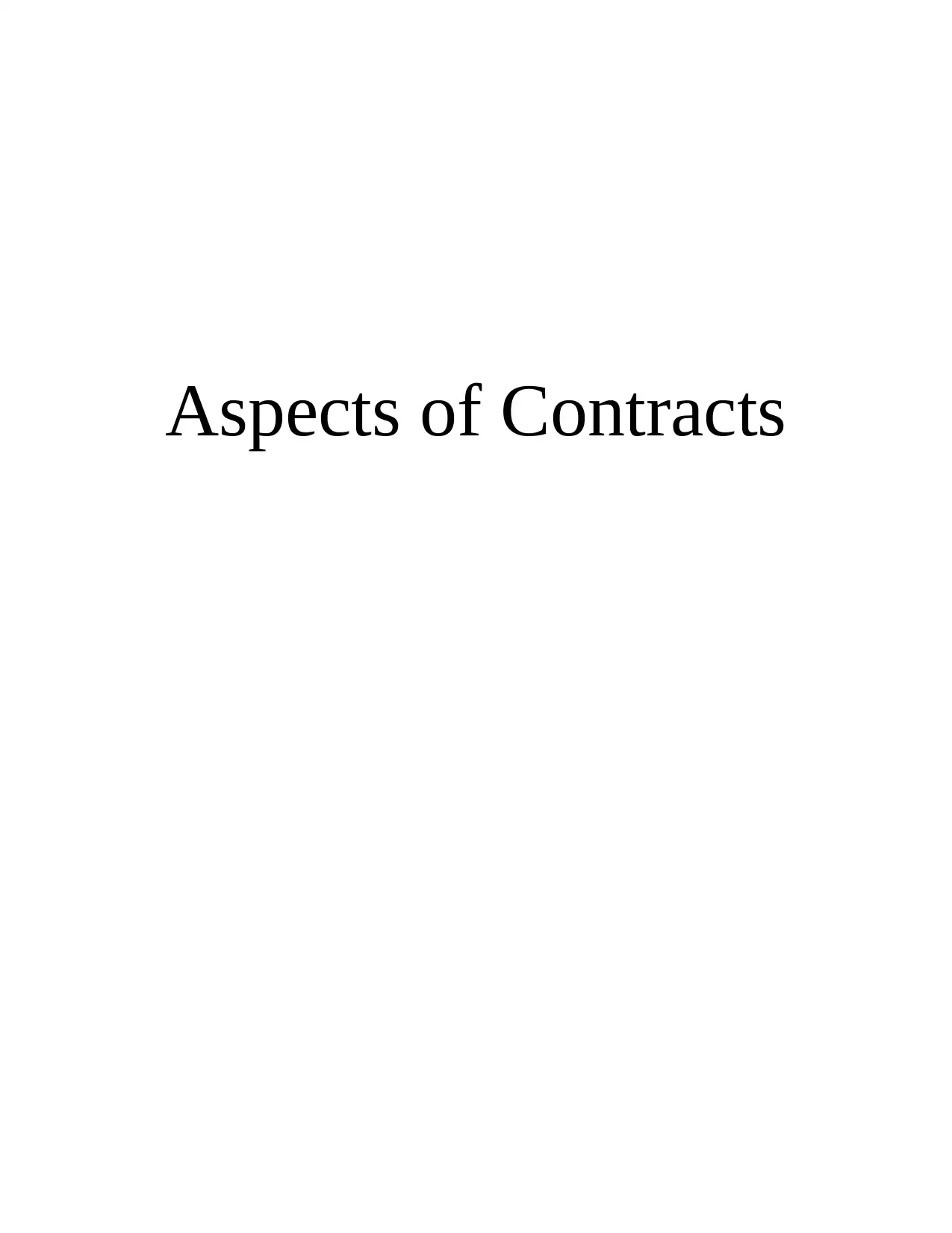
Aspects of Contracts
Paraphrase This Document
Need a fresh take? Get an instant paraphrase of this document with our AI Paraphraser
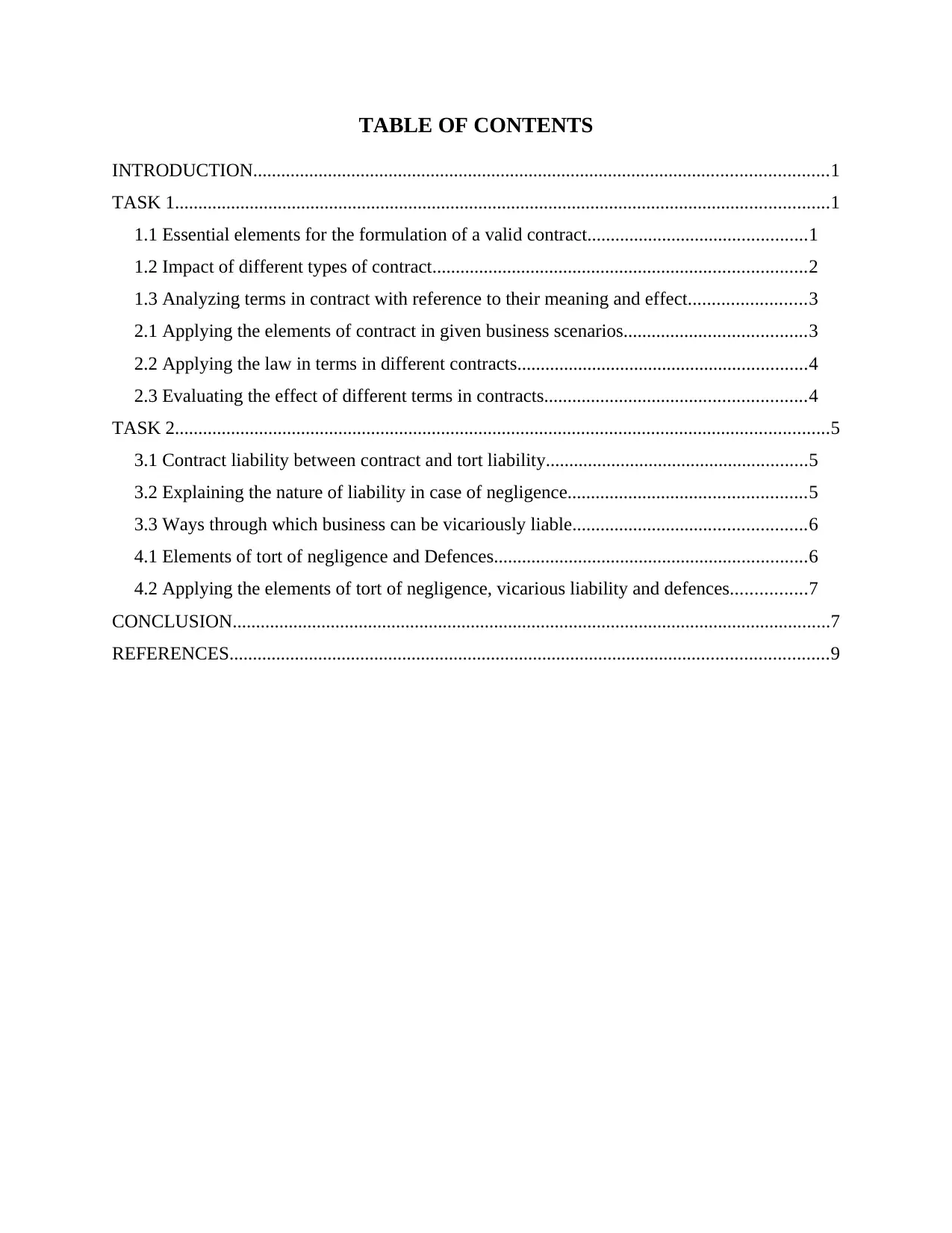
TABLE OF CONTENTS
INTRODUCTION...........................................................................................................................1
TASK 1............................................................................................................................................1
1.1 Essential elements for the formulation of a valid contract...............................................1
1.2 Impact of different types of contract................................................................................2
1.3 Analyzing terms in contract with reference to their meaning and effect.........................3
2.1 Applying the elements of contract in given business scenarios.......................................3
2.2 Applying the law in terms in different contracts..............................................................4
2.3 Evaluating the effect of different terms in contracts........................................................4
TASK 2............................................................................................................................................5
3.1 Contract liability between contract and tort liability........................................................5
3.2 Explaining the nature of liability in case of negligence...................................................5
3.3 Ways through which business can be vicariously liable..................................................6
4.1 Elements of tort of negligence and Defences...................................................................6
4.2 Applying the elements of tort of negligence, vicarious liability and defences................7
CONCLUSION................................................................................................................................7
REFERENCES................................................................................................................................9
INTRODUCTION...........................................................................................................................1
TASK 1............................................................................................................................................1
1.1 Essential elements for the formulation of a valid contract...............................................1
1.2 Impact of different types of contract................................................................................2
1.3 Analyzing terms in contract with reference to their meaning and effect.........................3
2.1 Applying the elements of contract in given business scenarios.......................................3
2.2 Applying the law in terms in different contracts..............................................................4
2.3 Evaluating the effect of different terms in contracts........................................................4
TASK 2............................................................................................................................................5
3.1 Contract liability between contract and tort liability........................................................5
3.2 Explaining the nature of liability in case of negligence...................................................5
3.3 Ways through which business can be vicariously liable..................................................6
4.1 Elements of tort of negligence and Defences...................................................................6
4.2 Applying the elements of tort of negligence, vicarious liability and defences................7
CONCLUSION................................................................................................................................7
REFERENCES................................................................................................................................9
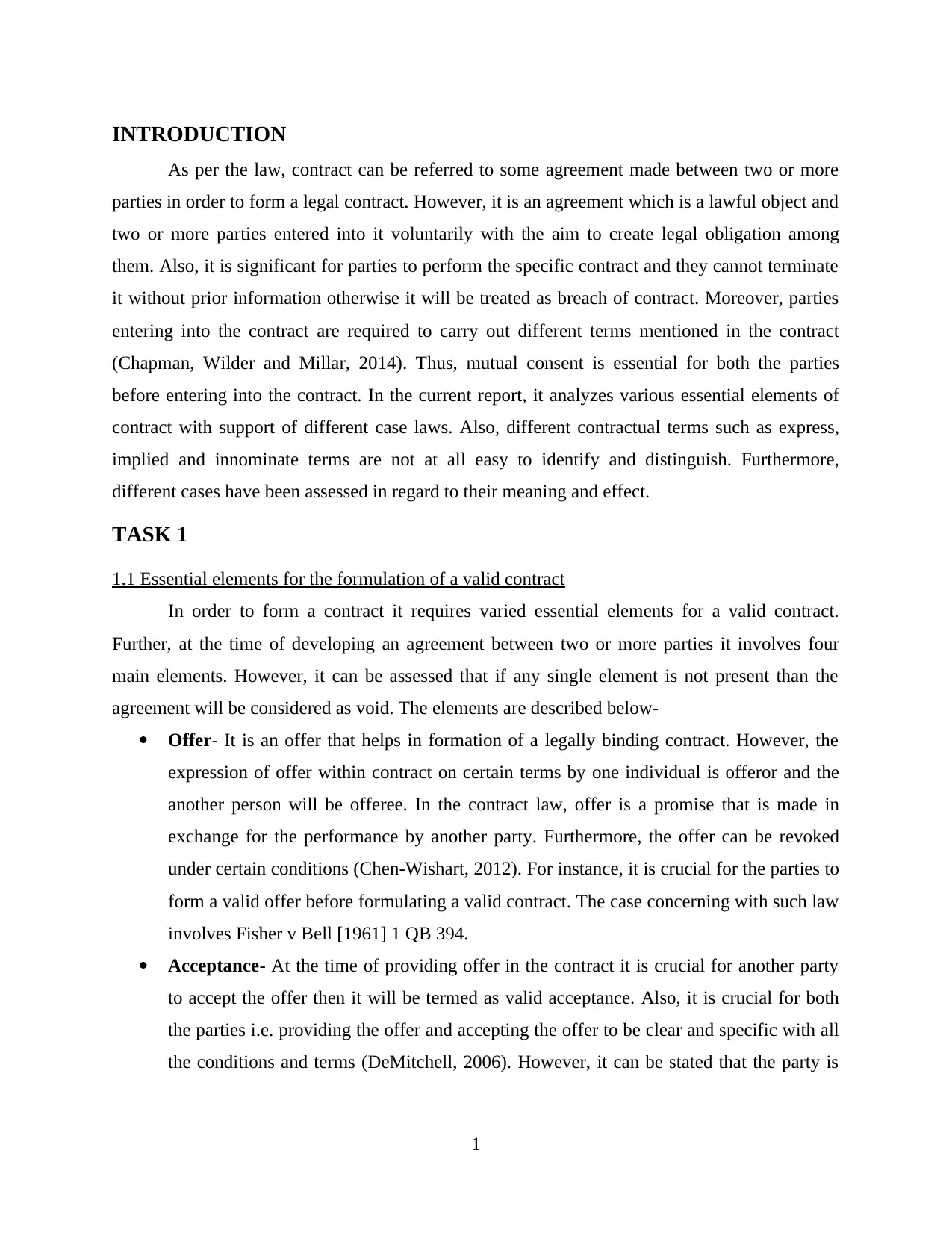
INTRODUCTION
As per the law, contract can be referred to some agreement made between two or more
parties in order to form a legal contract. However, it is an agreement which is a lawful object and
two or more parties entered into it voluntarily with the aim to create legal obligation among
them. Also, it is significant for parties to perform the specific contract and they cannot terminate
it without prior information otherwise it will be treated as breach of contract. Moreover, parties
entering into the contract are required to carry out different terms mentioned in the contract
(Chapman, Wilder and Millar, 2014). Thus, mutual consent is essential for both the parties
before entering into the contract. In the current report, it analyzes various essential elements of
contract with support of different case laws. Also, different contractual terms such as express,
implied and innominate terms are not at all easy to identify and distinguish. Furthermore,
different cases have been assessed in regard to their meaning and effect.
TASK 1
1.1 Essential elements for the formulation of a valid contract
In order to form a contract it requires varied essential elements for a valid contract.
Further, at the time of developing an agreement between two or more parties it involves four
main elements. However, it can be assessed that if any single element is not present than the
agreement will be considered as void. The elements are described below-
Offer- It is an offer that helps in formation of a legally binding contract. However, the
expression of offer within contract on certain terms by one individual is offeror and the
another person will be offeree. In the contract law, offer is a promise that is made in
exchange for the performance by another party. Furthermore, the offer can be revoked
under certain conditions (Chen-Wishart, 2012). For instance, it is crucial for the parties to
form a valid offer before formulating a valid contract. The case concerning with such law
involves Fisher v Bell [1961] 1 QB 394.
Acceptance- At the time of providing offer in the contract it is crucial for another party
to accept the offer then it will be termed as valid acceptance. Also, it is crucial for both
the parties i.e. providing the offer and accepting the offer to be clear and specific with all
the conditions and terms (DeMitchell, 2006). However, it can be stated that the party is
1
As per the law, contract can be referred to some agreement made between two or more
parties in order to form a legal contract. However, it is an agreement which is a lawful object and
two or more parties entered into it voluntarily with the aim to create legal obligation among
them. Also, it is significant for parties to perform the specific contract and they cannot terminate
it without prior information otherwise it will be treated as breach of contract. Moreover, parties
entering into the contract are required to carry out different terms mentioned in the contract
(Chapman, Wilder and Millar, 2014). Thus, mutual consent is essential for both the parties
before entering into the contract. In the current report, it analyzes various essential elements of
contract with support of different case laws. Also, different contractual terms such as express,
implied and innominate terms are not at all easy to identify and distinguish. Furthermore,
different cases have been assessed in regard to their meaning and effect.
TASK 1
1.1 Essential elements for the formulation of a valid contract
In order to form a contract it requires varied essential elements for a valid contract.
Further, at the time of developing an agreement between two or more parties it involves four
main elements. However, it can be assessed that if any single element is not present than the
agreement will be considered as void. The elements are described below-
Offer- It is an offer that helps in formation of a legally binding contract. However, the
expression of offer within contract on certain terms by one individual is offeror and the
another person will be offeree. In the contract law, offer is a promise that is made in
exchange for the performance by another party. Furthermore, the offer can be revoked
under certain conditions (Chen-Wishart, 2012). For instance, it is crucial for the parties to
form a valid offer before formulating a valid contract. The case concerning with such law
involves Fisher v Bell [1961] 1 QB 394.
Acceptance- At the time of providing offer in the contract it is crucial for another party
to accept the offer then it will be termed as valid acceptance. Also, it is crucial for both
the parties i.e. providing the offer and accepting the offer to be clear and specific with all
the conditions and terms (DeMitchell, 2006). However, it can be stated that the party is
1
⊘ This is a preview!⊘
Do you want full access?
Subscribe today to unlock all pages.

Trusted by 1+ million students worldwide
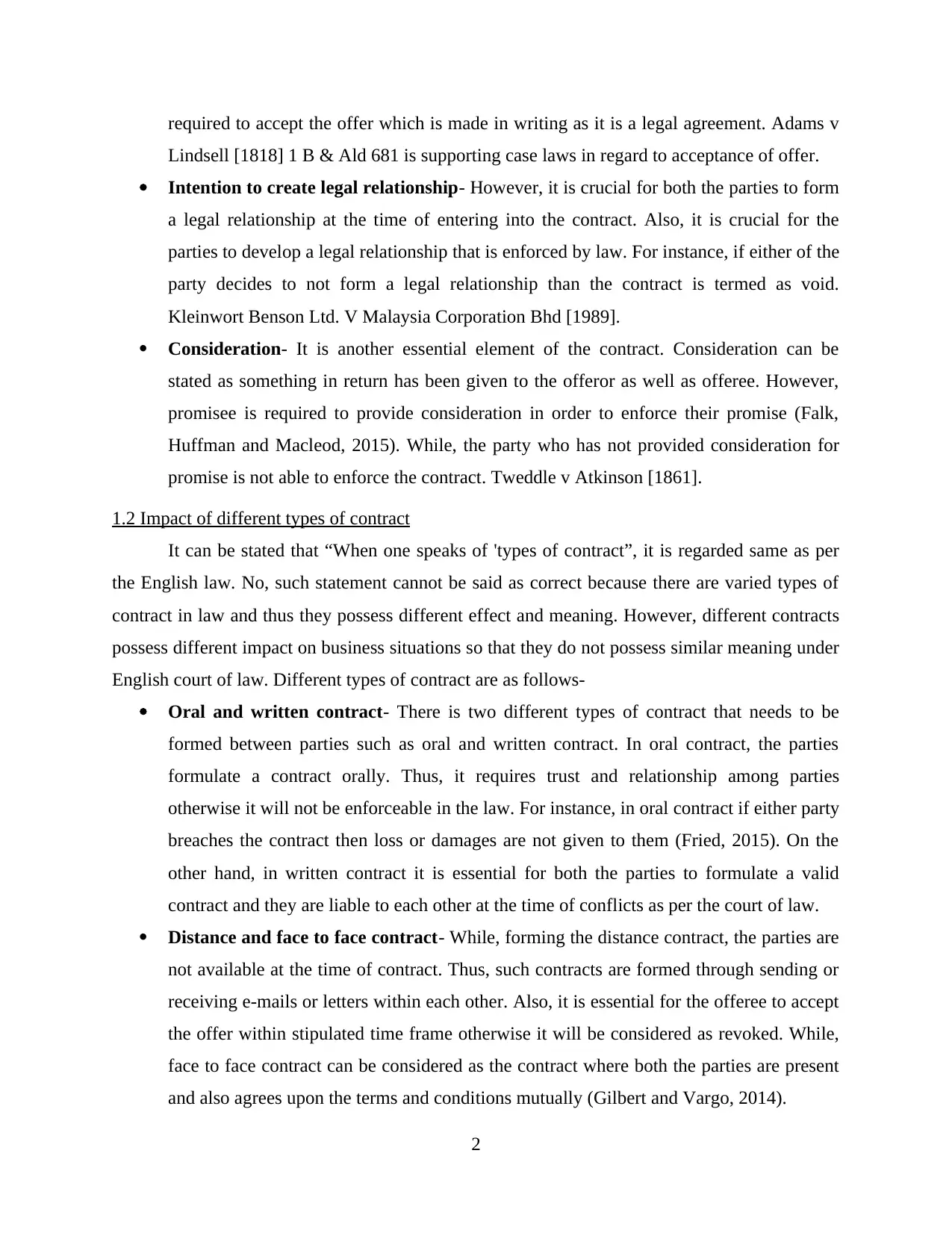
required to accept the offer which is made in writing as it is a legal agreement. Adams v
Lindsell [1818] 1 B & Ald 681 is supporting case laws in regard to acceptance of offer.
Intention to create legal relationship- However, it is crucial for both the parties to form
a legal relationship at the time of entering into the contract. Also, it is crucial for the
parties to develop a legal relationship that is enforced by law. For instance, if either of the
party decides to not form a legal relationship than the contract is termed as void.
Kleinwort Benson Ltd. V Malaysia Corporation Bhd [1989].
Consideration- It is another essential element of the contract. Consideration can be
stated as something in return has been given to the offeror as well as offeree. However,
promisee is required to provide consideration in order to enforce their promise (Falk,
Huffman and Macleod, 2015). While, the party who has not provided consideration for
promise is not able to enforce the contract. Tweddle v Atkinson [1861].
1.2 Impact of different types of contract
It can be stated that “When one speaks of 'types of contract”, it is regarded same as per
the English law. No, such statement cannot be said as correct because there are varied types of
contract in law and thus they possess different effect and meaning. However, different contracts
possess different impact on business situations so that they do not possess similar meaning under
English court of law. Different types of contract are as follows-
Oral and written contract- There is two different types of contract that needs to be
formed between parties such as oral and written contract. In oral contract, the parties
formulate a contract orally. Thus, it requires trust and relationship among parties
otherwise it will not be enforceable in the law. For instance, in oral contract if either party
breaches the contract then loss or damages are not given to them (Fried, 2015). On the
other hand, in written contract it is essential for both the parties to formulate a valid
contract and they are liable to each other at the time of conflicts as per the court of law.
Distance and face to face contract- While, forming the distance contract, the parties are
not available at the time of contract. Thus, such contracts are formed through sending or
receiving e-mails or letters within each other. Also, it is essential for the offeree to accept
the offer within stipulated time frame otherwise it will be considered as revoked. While,
face to face contract can be considered as the contract where both the parties are present
and also agrees upon the terms and conditions mutually (Gilbert and Vargo, 2014).
2
Lindsell [1818] 1 B & Ald 681 is supporting case laws in regard to acceptance of offer.
Intention to create legal relationship- However, it is crucial for both the parties to form
a legal relationship at the time of entering into the contract. Also, it is crucial for the
parties to develop a legal relationship that is enforced by law. For instance, if either of the
party decides to not form a legal relationship than the contract is termed as void.
Kleinwort Benson Ltd. V Malaysia Corporation Bhd [1989].
Consideration- It is another essential element of the contract. Consideration can be
stated as something in return has been given to the offeror as well as offeree. However,
promisee is required to provide consideration in order to enforce their promise (Falk,
Huffman and Macleod, 2015). While, the party who has not provided consideration for
promise is not able to enforce the contract. Tweddle v Atkinson [1861].
1.2 Impact of different types of contract
It can be stated that “When one speaks of 'types of contract”, it is regarded same as per
the English law. No, such statement cannot be said as correct because there are varied types of
contract in law and thus they possess different effect and meaning. However, different contracts
possess different impact on business situations so that they do not possess similar meaning under
English court of law. Different types of contract are as follows-
Oral and written contract- There is two different types of contract that needs to be
formed between parties such as oral and written contract. In oral contract, the parties
formulate a contract orally. Thus, it requires trust and relationship among parties
otherwise it will not be enforceable in the law. For instance, in oral contract if either party
breaches the contract then loss or damages are not given to them (Fried, 2015). On the
other hand, in written contract it is essential for both the parties to formulate a valid
contract and they are liable to each other at the time of conflicts as per the court of law.
Distance and face to face contract- While, forming the distance contract, the parties are
not available at the time of contract. Thus, such contracts are formed through sending or
receiving e-mails or letters within each other. Also, it is essential for the offeree to accept
the offer within stipulated time frame otherwise it will be considered as revoked. While,
face to face contract can be considered as the contract where both the parties are present
and also agrees upon the terms and conditions mutually (Gilbert and Vargo, 2014).
2
Paraphrase This Document
Need a fresh take? Get an instant paraphrase of this document with our AI Paraphraser
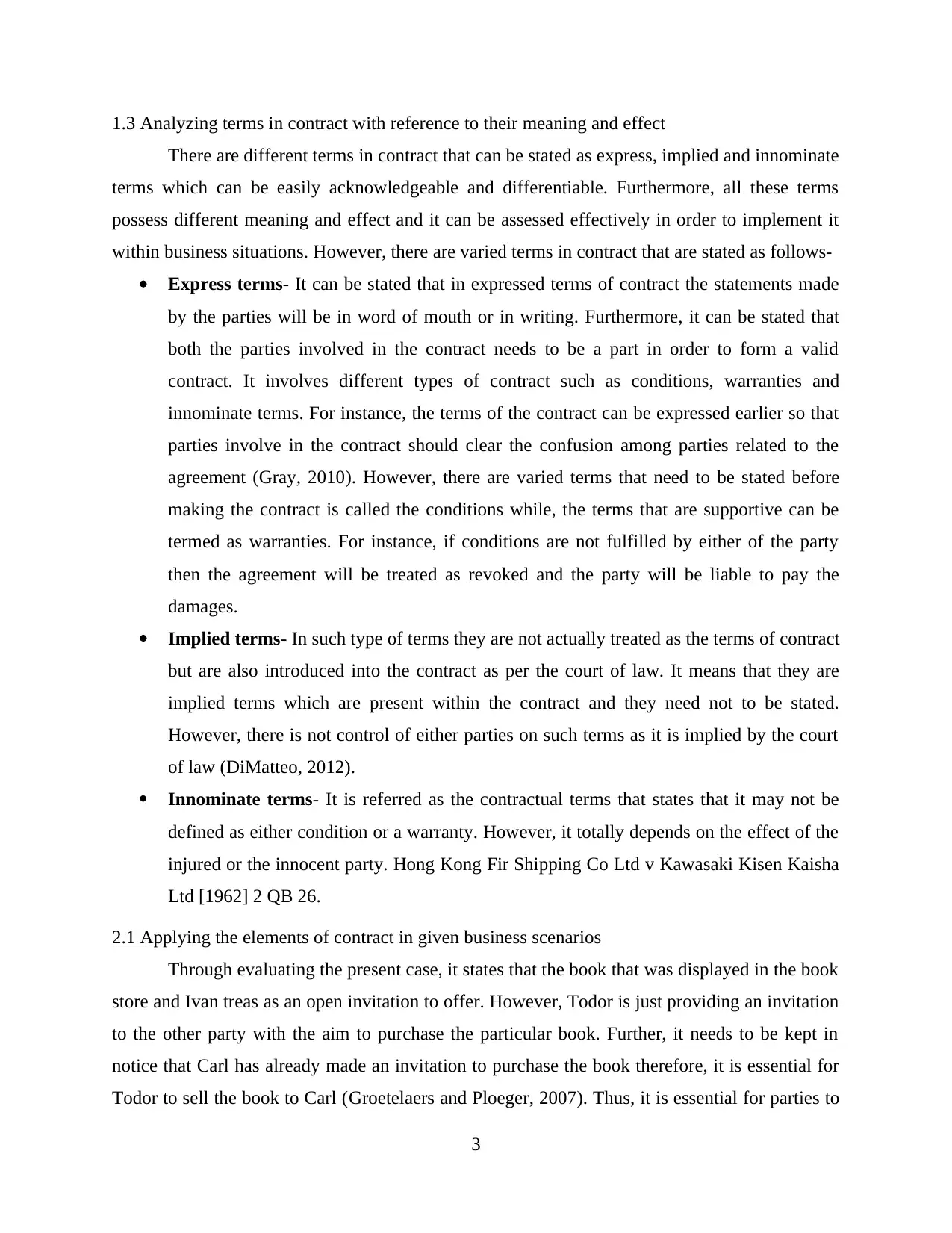
1.3 Analyzing terms in contract with reference to their meaning and effect
There are different terms in contract that can be stated as express, implied and innominate
terms which can be easily acknowledgeable and differentiable. Furthermore, all these terms
possess different meaning and effect and it can be assessed effectively in order to implement it
within business situations. However, there are varied terms in contract that are stated as follows-
Express terms- It can be stated that in expressed terms of contract the statements made
by the parties will be in word of mouth or in writing. Furthermore, it can be stated that
both the parties involved in the contract needs to be a part in order to form a valid
contract. It involves different types of contract such as conditions, warranties and
innominate terms. For instance, the terms of the contract can be expressed earlier so that
parties involve in the contract should clear the confusion among parties related to the
agreement (Gray, 2010). However, there are varied terms that need to be stated before
making the contract is called the conditions while, the terms that are supportive can be
termed as warranties. For instance, if conditions are not fulfilled by either of the party
then the agreement will be treated as revoked and the party will be liable to pay the
damages.
Implied terms- In such type of terms they are not actually treated as the terms of contract
but are also introduced into the contract as per the court of law. It means that they are
implied terms which are present within the contract and they need not to be stated.
However, there is not control of either parties on such terms as it is implied by the court
of law (DiMatteo, 2012).
Innominate terms- It is referred as the contractual terms that states that it may not be
defined as either condition or a warranty. However, it totally depends on the effect of the
injured or the innocent party. Hong Kong Fir Shipping Co Ltd v Kawasaki Kisen Kaisha
Ltd [1962] 2 QB 26.
2.1 Applying the elements of contract in given business scenarios
Through evaluating the present case, it states that the book that was displayed in the book
store and Ivan treas as an open invitation to offer. However, Todor is just providing an invitation
to the other party with the aim to purchase the particular book. Further, it needs to be kept in
notice that Carl has already made an invitation to purchase the book therefore, it is essential for
Todor to sell the book to Carl (Groetelaers and Ploeger, 2007). Thus, it is essential for parties to
3
There are different terms in contract that can be stated as express, implied and innominate
terms which can be easily acknowledgeable and differentiable. Furthermore, all these terms
possess different meaning and effect and it can be assessed effectively in order to implement it
within business situations. However, there are varied terms in contract that are stated as follows-
Express terms- It can be stated that in expressed terms of contract the statements made
by the parties will be in word of mouth or in writing. Furthermore, it can be stated that
both the parties involved in the contract needs to be a part in order to form a valid
contract. It involves different types of contract such as conditions, warranties and
innominate terms. For instance, the terms of the contract can be expressed earlier so that
parties involve in the contract should clear the confusion among parties related to the
agreement (Gray, 2010). However, there are varied terms that need to be stated before
making the contract is called the conditions while, the terms that are supportive can be
termed as warranties. For instance, if conditions are not fulfilled by either of the party
then the agreement will be treated as revoked and the party will be liable to pay the
damages.
Implied terms- In such type of terms they are not actually treated as the terms of contract
but are also introduced into the contract as per the court of law. It means that they are
implied terms which are present within the contract and they need not to be stated.
However, there is not control of either parties on such terms as it is implied by the court
of law (DiMatteo, 2012).
Innominate terms- It is referred as the contractual terms that states that it may not be
defined as either condition or a warranty. However, it totally depends on the effect of the
injured or the innocent party. Hong Kong Fir Shipping Co Ltd v Kawasaki Kisen Kaisha
Ltd [1962] 2 QB 26.
2.1 Applying the elements of contract in given business scenarios
Through evaluating the present case, it states that the book that was displayed in the book
store and Ivan treas as an open invitation to offer. However, Todor is just providing an invitation
to the other party with the aim to purchase the particular book. Further, it needs to be kept in
notice that Carl has already made an invitation to purchase the book therefore, it is essential for
Todor to sell the book to Carl (Groetelaers and Ploeger, 2007). Thus, it is essential for parties to
3
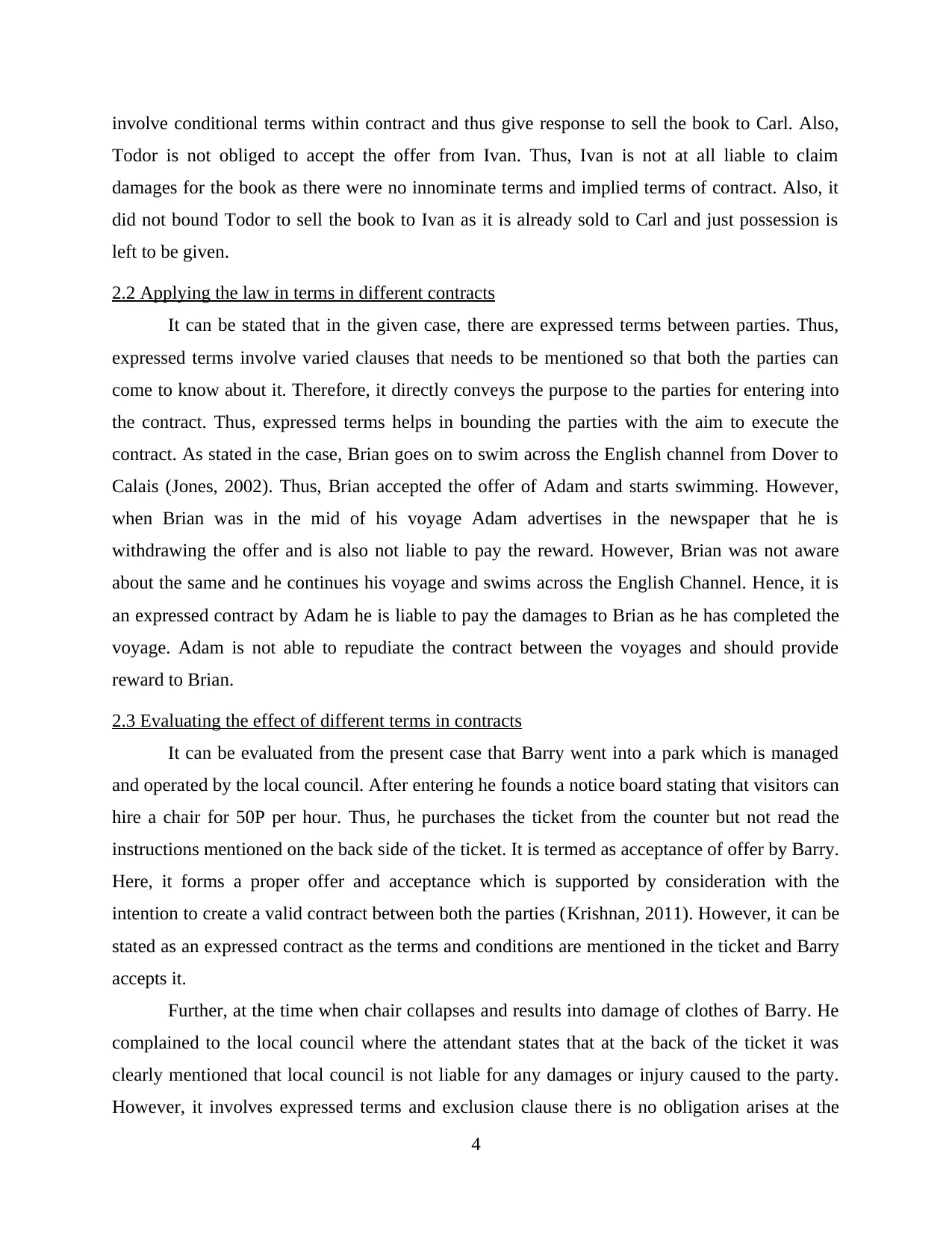
involve conditional terms within contract and thus give response to sell the book to Carl. Also,
Todor is not obliged to accept the offer from Ivan. Thus, Ivan is not at all liable to claim
damages for the book as there were no innominate terms and implied terms of contract. Also, it
did not bound Todor to sell the book to Ivan as it is already sold to Carl and just possession is
left to be given.
2.2 Applying the law in terms in different contracts
It can be stated that in the given case, there are expressed terms between parties. Thus,
expressed terms involve varied clauses that needs to be mentioned so that both the parties can
come to know about it. Therefore, it directly conveys the purpose to the parties for entering into
the contract. Thus, expressed terms helps in bounding the parties with the aim to execute the
contract. As stated in the case, Brian goes on to swim across the English channel from Dover to
Calais (Jones, 2002). Thus, Brian accepted the offer of Adam and starts swimming. However,
when Brian was in the mid of his voyage Adam advertises in the newspaper that he is
withdrawing the offer and is also not liable to pay the reward. However, Brian was not aware
about the same and he continues his voyage and swims across the English Channel. Hence, it is
an expressed contract by Adam he is liable to pay the damages to Brian as he has completed the
voyage. Adam is not able to repudiate the contract between the voyages and should provide
reward to Brian.
2.3 Evaluating the effect of different terms in contracts
It can be evaluated from the present case that Barry went into a park which is managed
and operated by the local council. After entering he founds a notice board stating that visitors can
hire a chair for 50P per hour. Thus, he purchases the ticket from the counter but not read the
instructions mentioned on the back side of the ticket. It is termed as acceptance of offer by Barry.
Here, it forms a proper offer and acceptance which is supported by consideration with the
intention to create a valid contract between both the parties (Krishnan, 2011). However, it can be
stated as an expressed contract as the terms and conditions are mentioned in the ticket and Barry
accepts it.
Further, at the time when chair collapses and results into damage of clothes of Barry. He
complained to the local council where the attendant states that at the back of the ticket it was
clearly mentioned that local council is not liable for any damages or injury caused to the party.
However, it involves expressed terms and exclusion clause there is no obligation arises at the
4
Todor is not obliged to accept the offer from Ivan. Thus, Ivan is not at all liable to claim
damages for the book as there were no innominate terms and implied terms of contract. Also, it
did not bound Todor to sell the book to Ivan as it is already sold to Carl and just possession is
left to be given.
2.2 Applying the law in terms in different contracts
It can be stated that in the given case, there are expressed terms between parties. Thus,
expressed terms involve varied clauses that needs to be mentioned so that both the parties can
come to know about it. Therefore, it directly conveys the purpose to the parties for entering into
the contract. Thus, expressed terms helps in bounding the parties with the aim to execute the
contract. As stated in the case, Brian goes on to swim across the English channel from Dover to
Calais (Jones, 2002). Thus, Brian accepted the offer of Adam and starts swimming. However,
when Brian was in the mid of his voyage Adam advertises in the newspaper that he is
withdrawing the offer and is also not liable to pay the reward. However, Brian was not aware
about the same and he continues his voyage and swims across the English Channel. Hence, it is
an expressed contract by Adam he is liable to pay the damages to Brian as he has completed the
voyage. Adam is not able to repudiate the contract between the voyages and should provide
reward to Brian.
2.3 Evaluating the effect of different terms in contracts
It can be evaluated from the present case that Barry went into a park which is managed
and operated by the local council. After entering he founds a notice board stating that visitors can
hire a chair for 50P per hour. Thus, he purchases the ticket from the counter but not read the
instructions mentioned on the back side of the ticket. It is termed as acceptance of offer by Barry.
Here, it forms a proper offer and acceptance which is supported by consideration with the
intention to create a valid contract between both the parties (Krishnan, 2011). However, it can be
stated as an expressed contract as the terms and conditions are mentioned in the ticket and Barry
accepts it.
Further, at the time when chair collapses and results into damage of clothes of Barry. He
complained to the local council where the attendant states that at the back of the ticket it was
clearly mentioned that local council is not liable for any damages or injury caused to the party.
However, it involves expressed terms and exclusion clause there is no obligation arises at the
4
⊘ This is a preview!⊘
Do you want full access?
Subscribe today to unlock all pages.

Trusted by 1+ million students worldwide
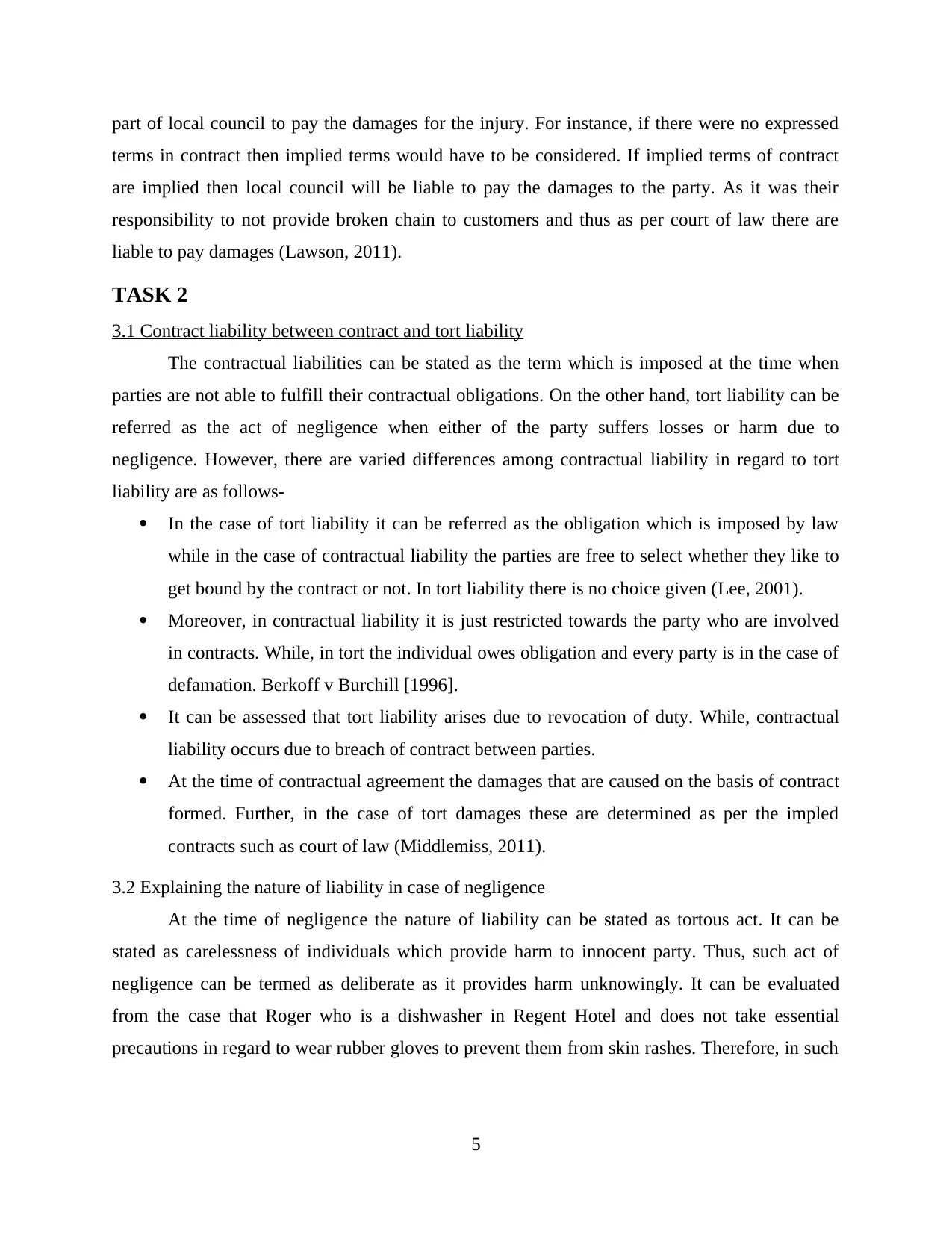
part of local council to pay the damages for the injury. For instance, if there were no expressed
terms in contract then implied terms would have to be considered. If implied terms of contract
are implied then local council will be liable to pay the damages to the party. As it was their
responsibility to not provide broken chain to customers and thus as per court of law there are
liable to pay damages (Lawson, 2011).
TASK 2
3.1 Contract liability between contract and tort liability
The contractual liabilities can be stated as the term which is imposed at the time when
parties are not able to fulfill their contractual obligations. On the other hand, tort liability can be
referred as the act of negligence when either of the party suffers losses or harm due to
negligence. However, there are varied differences among contractual liability in regard to tort
liability are as follows-
In the case of tort liability it can be referred as the obligation which is imposed by law
while in the case of contractual liability the parties are free to select whether they like to
get bound by the contract or not. In tort liability there is no choice given (Lee, 2001).
Moreover, in contractual liability it is just restricted towards the party who are involved
in contracts. While, in tort the individual owes obligation and every party is in the case of
defamation. Berkoff v Burchill [1996].
It can be assessed that tort liability arises due to revocation of duty. While, contractual
liability occurs due to breach of contract between parties.
At the time of contractual agreement the damages that are caused on the basis of contract
formed. Further, in the case of tort damages these are determined as per the impled
contracts such as court of law (Middlemiss, 2011).
3.2 Explaining the nature of liability in case of negligence
At the time of negligence the nature of liability can be stated as tortous act. It can be
stated as carelessness of individuals which provide harm to innocent party. Thus, such act of
negligence can be termed as deliberate as it provides harm unknowingly. It can be evaluated
from the case that Roger who is a dishwasher in Regent Hotel and does not take essential
precautions in regard to wear rubber gloves to prevent them from skin rashes. Therefore, in such
5
terms in contract then implied terms would have to be considered. If implied terms of contract
are implied then local council will be liable to pay the damages to the party. As it was their
responsibility to not provide broken chain to customers and thus as per court of law there are
liable to pay damages (Lawson, 2011).
TASK 2
3.1 Contract liability between contract and tort liability
The contractual liabilities can be stated as the term which is imposed at the time when
parties are not able to fulfill their contractual obligations. On the other hand, tort liability can be
referred as the act of negligence when either of the party suffers losses or harm due to
negligence. However, there are varied differences among contractual liability in regard to tort
liability are as follows-
In the case of tort liability it can be referred as the obligation which is imposed by law
while in the case of contractual liability the parties are free to select whether they like to
get bound by the contract or not. In tort liability there is no choice given (Lee, 2001).
Moreover, in contractual liability it is just restricted towards the party who are involved
in contracts. While, in tort the individual owes obligation and every party is in the case of
defamation. Berkoff v Burchill [1996].
It can be assessed that tort liability arises due to revocation of duty. While, contractual
liability occurs due to breach of contract between parties.
At the time of contractual agreement the damages that are caused on the basis of contract
formed. Further, in the case of tort damages these are determined as per the impled
contracts such as court of law (Middlemiss, 2011).
3.2 Explaining the nature of liability in case of negligence
At the time of negligence the nature of liability can be stated as tortous act. It can be
stated as carelessness of individuals which provide harm to innocent party. Thus, such act of
negligence can be termed as deliberate as it provides harm unknowingly. It can be evaluated
from the case that Roger who is a dishwasher in Regent Hotel and does not take essential
precautions in regard to wear rubber gloves to prevent them from skin rashes. Therefore, in such
5
Paraphrase This Document
Need a fresh take? Get an instant paraphrase of this document with our AI Paraphraser
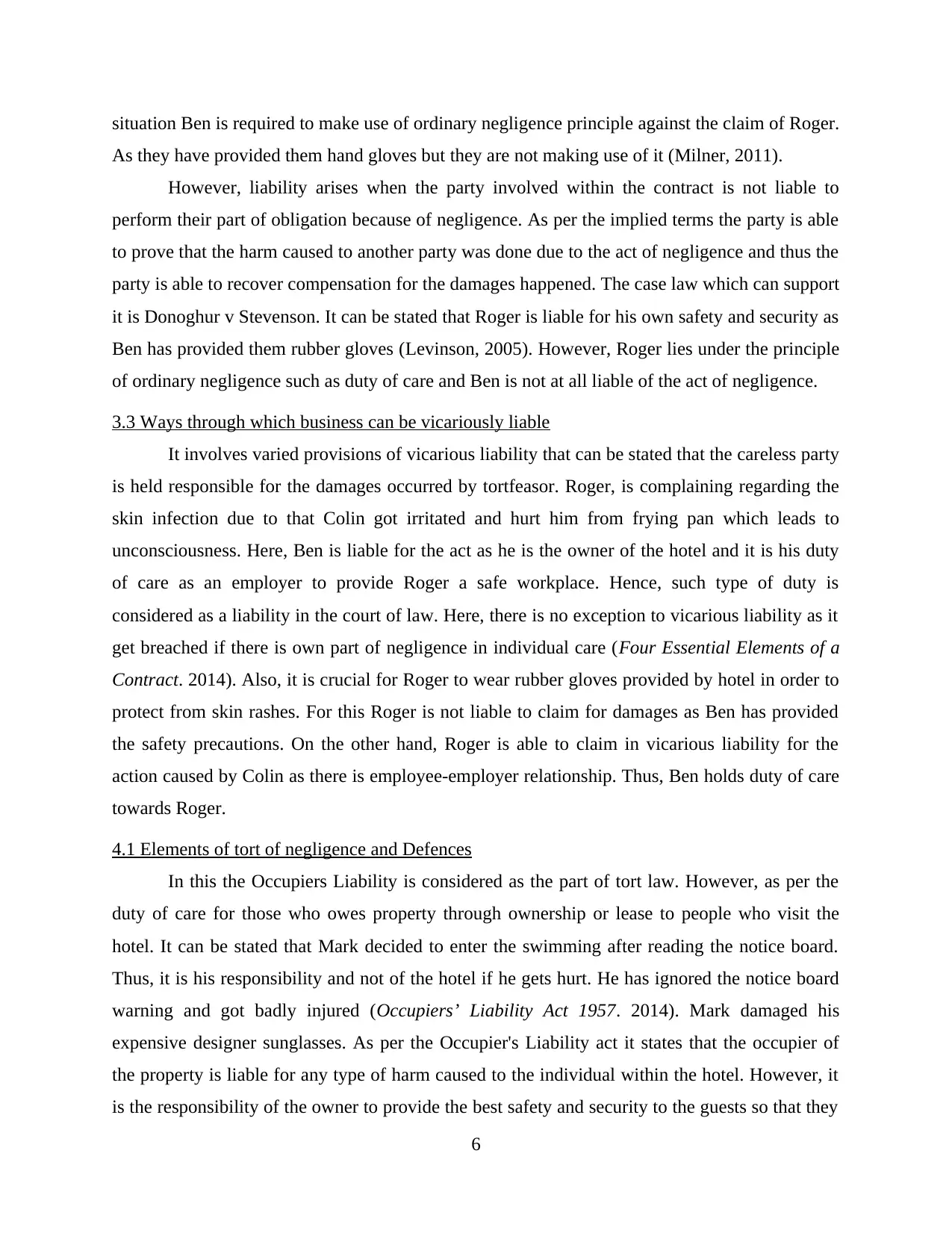
situation Ben is required to make use of ordinary negligence principle against the claim of Roger.
As they have provided them hand gloves but they are not making use of it (Milner, 2011).
However, liability arises when the party involved within the contract is not liable to
perform their part of obligation because of negligence. As per the implied terms the party is able
to prove that the harm caused to another party was done due to the act of negligence and thus the
party is able to recover compensation for the damages happened. The case law which can support
it is Donoghur v Stevenson. It can be stated that Roger is liable for his own safety and security as
Ben has provided them rubber gloves (Levinson, 2005). However, Roger lies under the principle
of ordinary negligence such as duty of care and Ben is not at all liable of the act of negligence.
3.3 Ways through which business can be vicariously liable
It involves varied provisions of vicarious liability that can be stated that the careless party
is held responsible for the damages occurred by tortfeasor. Roger, is complaining regarding the
skin infection due to that Colin got irritated and hurt him from frying pan which leads to
unconsciousness. Here, Ben is liable for the act as he is the owner of the hotel and it is his duty
of care as an employer to provide Roger a safe workplace. Hence, such type of duty is
considered as a liability in the court of law. Here, there is no exception to vicarious liability as it
get breached if there is own part of negligence in individual care (Four Essential Elements of a
Contract. 2014). Also, it is crucial for Roger to wear rubber gloves provided by hotel in order to
protect from skin rashes. For this Roger is not liable to claim for damages as Ben has provided
the safety precautions. On the other hand, Roger is able to claim in vicarious liability for the
action caused by Colin as there is employee-employer relationship. Thus, Ben holds duty of care
towards Roger.
4.1 Elements of tort of negligence and Defences
In this the Occupiers Liability is considered as the part of tort law. However, as per the
duty of care for those who owes property through ownership or lease to people who visit the
hotel. It can be stated that Mark decided to enter the swimming after reading the notice board.
Thus, it is his responsibility and not of the hotel if he gets hurt. He has ignored the notice board
warning and got badly injured (Occupiers’ Liability Act 1957. 2014). Mark damaged his
expensive designer sunglasses. As per the Occupier's Liability act it states that the occupier of
the property is liable for any type of harm caused to the individual within the hotel. However, it
is the responsibility of the owner to provide the best safety and security to the guests so that they
6
As they have provided them hand gloves but they are not making use of it (Milner, 2011).
However, liability arises when the party involved within the contract is not liable to
perform their part of obligation because of negligence. As per the implied terms the party is able
to prove that the harm caused to another party was done due to the act of negligence and thus the
party is able to recover compensation for the damages happened. The case law which can support
it is Donoghur v Stevenson. It can be stated that Roger is liable for his own safety and security as
Ben has provided them rubber gloves (Levinson, 2005). However, Roger lies under the principle
of ordinary negligence such as duty of care and Ben is not at all liable of the act of negligence.
3.3 Ways through which business can be vicariously liable
It involves varied provisions of vicarious liability that can be stated that the careless party
is held responsible for the damages occurred by tortfeasor. Roger, is complaining regarding the
skin infection due to that Colin got irritated and hurt him from frying pan which leads to
unconsciousness. Here, Ben is liable for the act as he is the owner of the hotel and it is his duty
of care as an employer to provide Roger a safe workplace. Hence, such type of duty is
considered as a liability in the court of law. Here, there is no exception to vicarious liability as it
get breached if there is own part of negligence in individual care (Four Essential Elements of a
Contract. 2014). Also, it is crucial for Roger to wear rubber gloves provided by hotel in order to
protect from skin rashes. For this Roger is not liable to claim for damages as Ben has provided
the safety precautions. On the other hand, Roger is able to claim in vicarious liability for the
action caused by Colin as there is employee-employer relationship. Thus, Ben holds duty of care
towards Roger.
4.1 Elements of tort of negligence and Defences
In this the Occupiers Liability is considered as the part of tort law. However, as per the
duty of care for those who owes property through ownership or lease to people who visit the
hotel. It can be stated that Mark decided to enter the swimming after reading the notice board.
Thus, it is his responsibility and not of the hotel if he gets hurt. He has ignored the notice board
warning and got badly injured (Occupiers’ Liability Act 1957. 2014). Mark damaged his
expensive designer sunglasses. As per the Occupier's Liability act it states that the occupier of
the property is liable for any type of harm caused to the individual within the hotel. However, it
is the responsibility of the owner to provide the best safety and security to the guests so that they
6
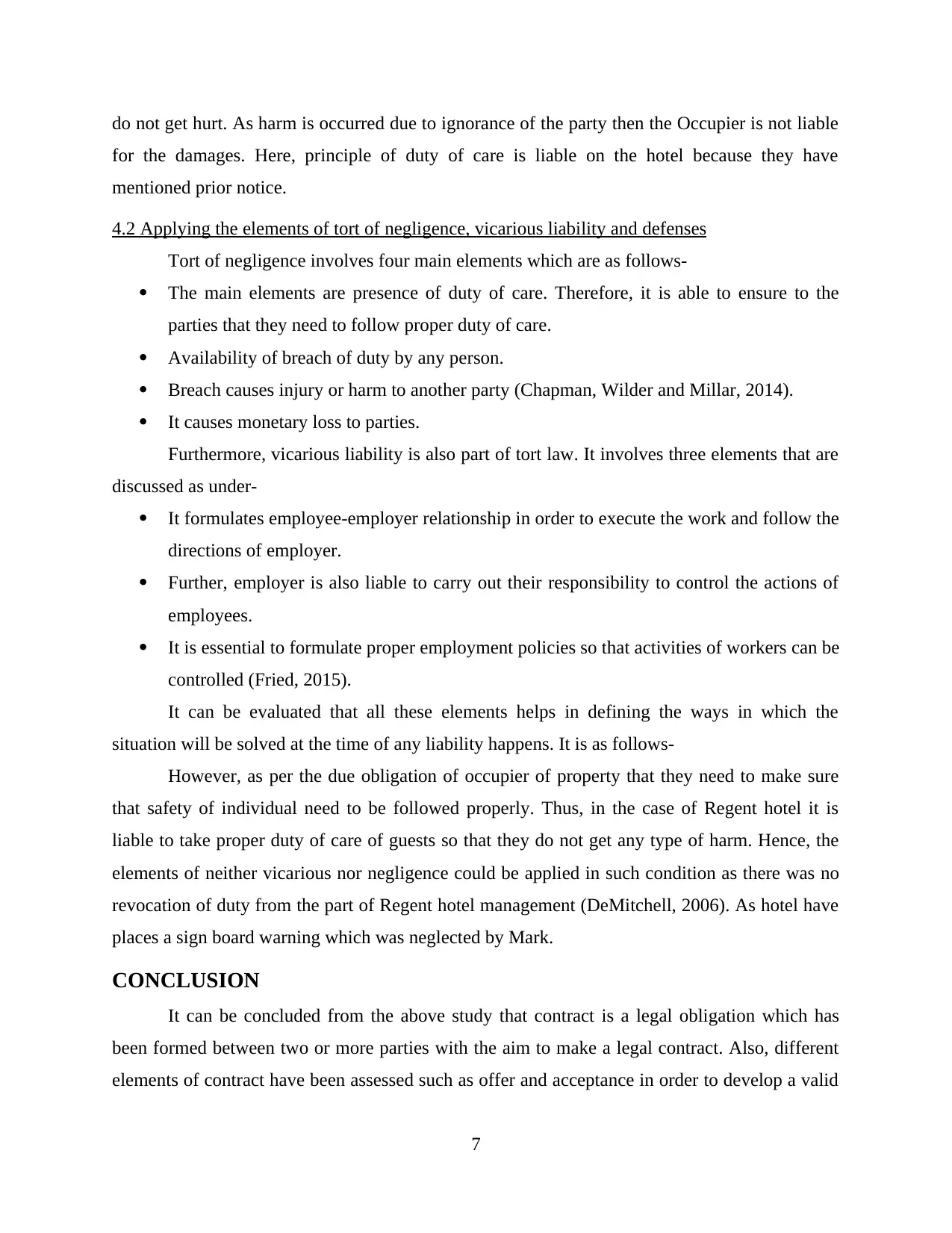
do not get hurt. As harm is occurred due to ignorance of the party then the Occupier is not liable
for the damages. Here, principle of duty of care is liable on the hotel because they have
mentioned prior notice.
4.2 Applying the elements of tort of negligence, vicarious liability and defenses
Tort of negligence involves four main elements which are as follows-
The main elements are presence of duty of care. Therefore, it is able to ensure to the
parties that they need to follow proper duty of care.
Availability of breach of duty by any person.
Breach causes injury or harm to another party (Chapman, Wilder and Millar, 2014).
It causes monetary loss to parties.
Furthermore, vicarious liability is also part of tort law. It involves three elements that are
discussed as under-
It formulates employee-employer relationship in order to execute the work and follow the
directions of employer.
Further, employer is also liable to carry out their responsibility to control the actions of
employees.
It is essential to formulate proper employment policies so that activities of workers can be
controlled (Fried, 2015).
It can be evaluated that all these elements helps in defining the ways in which the
situation will be solved at the time of any liability happens. It is as follows-
However, as per the due obligation of occupier of property that they need to make sure
that safety of individual need to be followed properly. Thus, in the case of Regent hotel it is
liable to take proper duty of care of guests so that they do not get any type of harm. Hence, the
elements of neither vicarious nor negligence could be applied in such condition as there was no
revocation of duty from the part of Regent hotel management (DeMitchell, 2006). As hotel have
places a sign board warning which was neglected by Mark.
CONCLUSION
It can be concluded from the above study that contract is a legal obligation which has
been formed between two or more parties with the aim to make a legal contract. Also, different
elements of contract have been assessed such as offer and acceptance in order to develop a valid
7
for the damages. Here, principle of duty of care is liable on the hotel because they have
mentioned prior notice.
4.2 Applying the elements of tort of negligence, vicarious liability and defenses
Tort of negligence involves four main elements which are as follows-
The main elements are presence of duty of care. Therefore, it is able to ensure to the
parties that they need to follow proper duty of care.
Availability of breach of duty by any person.
Breach causes injury or harm to another party (Chapman, Wilder and Millar, 2014).
It causes monetary loss to parties.
Furthermore, vicarious liability is also part of tort law. It involves three elements that are
discussed as under-
It formulates employee-employer relationship in order to execute the work and follow the
directions of employer.
Further, employer is also liable to carry out their responsibility to control the actions of
employees.
It is essential to formulate proper employment policies so that activities of workers can be
controlled (Fried, 2015).
It can be evaluated that all these elements helps in defining the ways in which the
situation will be solved at the time of any liability happens. It is as follows-
However, as per the due obligation of occupier of property that they need to make sure
that safety of individual need to be followed properly. Thus, in the case of Regent hotel it is
liable to take proper duty of care of guests so that they do not get any type of harm. Hence, the
elements of neither vicarious nor negligence could be applied in such condition as there was no
revocation of duty from the part of Regent hotel management (DeMitchell, 2006). As hotel have
places a sign board warning which was neglected by Mark.
CONCLUSION
It can be concluded from the above study that contract is a legal obligation which has
been formed between two or more parties with the aim to make a legal contract. Also, different
elements of contract have been assessed such as offer and acceptance in order to develop a valid
7
⊘ This is a preview!⊘
Do you want full access?
Subscribe today to unlock all pages.

Trusted by 1+ million students worldwide
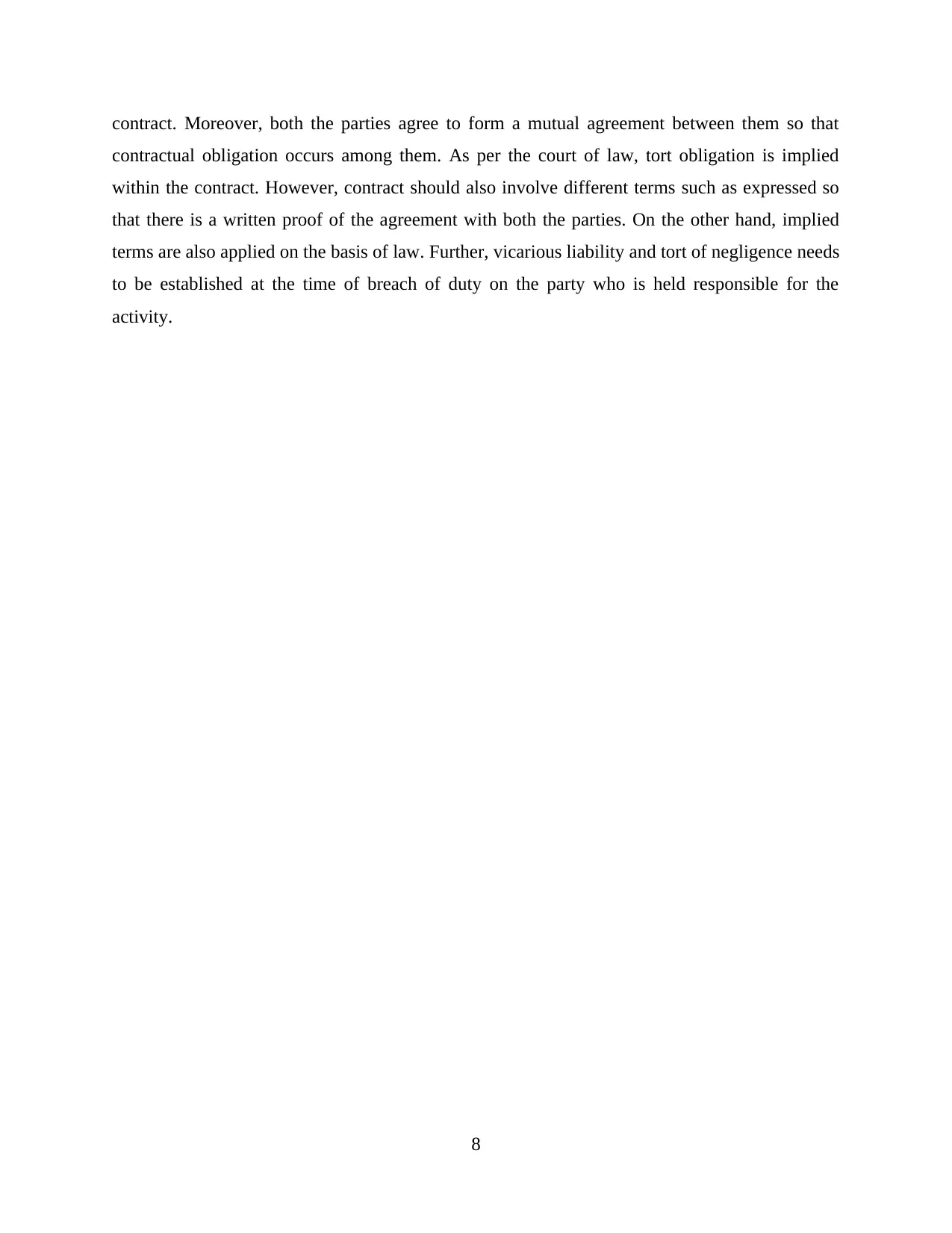
contract. Moreover, both the parties agree to form a mutual agreement between them so that
contractual obligation occurs among them. As per the court of law, tort obligation is implied
within the contract. However, contract should also involve different terms such as expressed so
that there is a written proof of the agreement with both the parties. On the other hand, implied
terms are also applied on the basis of law. Further, vicarious liability and tort of negligence needs
to be established at the time of breach of duty on the party who is held responsible for the
activity.
8
contractual obligation occurs among them. As per the court of law, tort obligation is implied
within the contract. However, contract should also involve different terms such as expressed so
that there is a written proof of the agreement with both the parties. On the other hand, implied
terms are also applied on the basis of law. Further, vicarious liability and tort of negligence needs
to be established at the time of breach of duty on the party who is held responsible for the
activity.
8
Paraphrase This Document
Need a fresh take? Get an instant paraphrase of this document with our AI Paraphraser
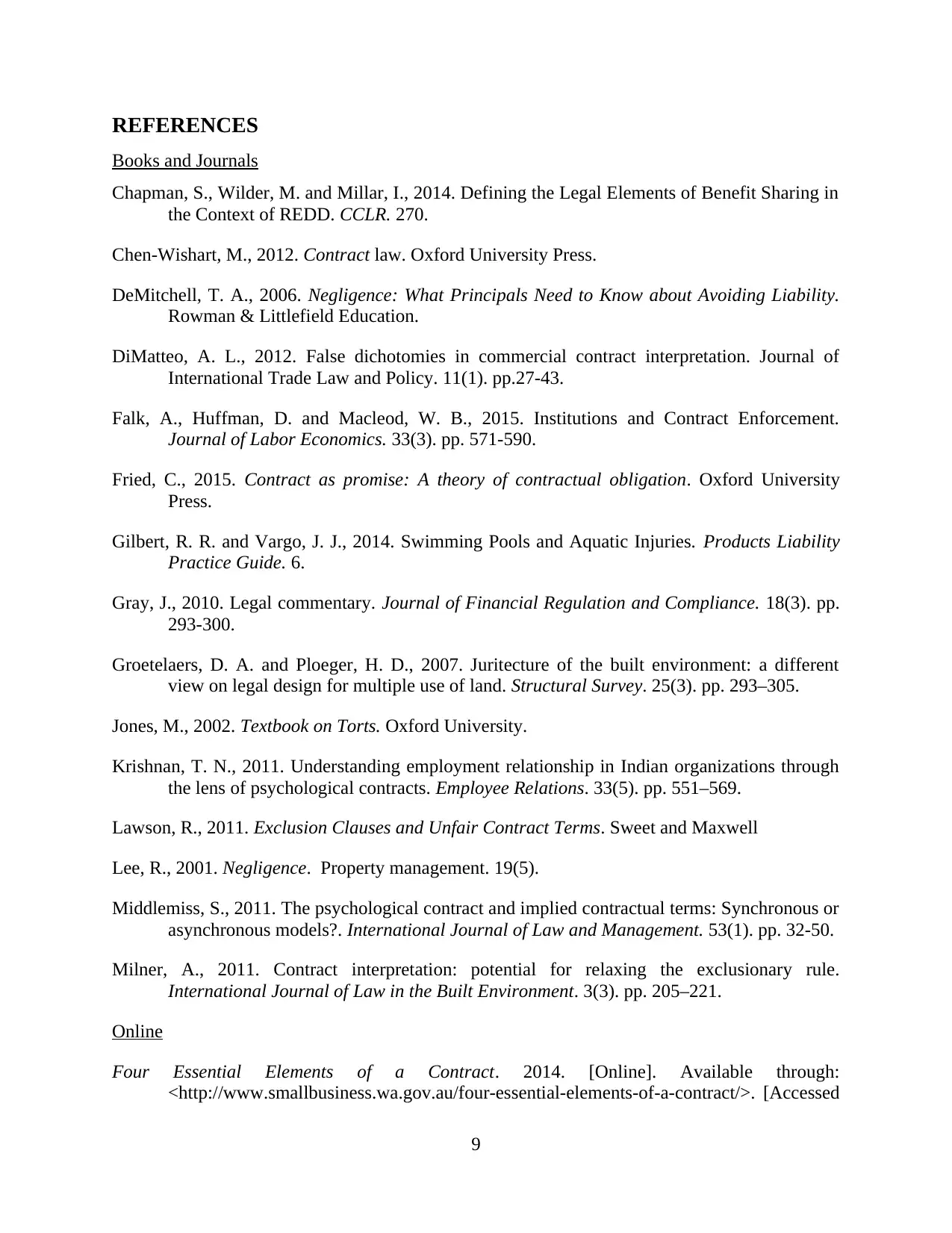
REFERENCES
Books and Journals
Chapman, S., Wilder, M. and Millar, I., 2014. Defining the Legal Elements of Benefit Sharing in
the Context of REDD. CCLR. 270.
Chen-Wishart, M., 2012. Contract law. Oxford University Press.
DeMitchell, T. A., 2006. Negligence: What Principals Need to Know about Avoiding Liability.
Rowman & Littlefield Education.
DiMatteo, A. L., 2012. False dichotomies in commercial contract interpretation. Journal of
International Trade Law and Policy. 11(1). pp.27-43.
Falk, A., Huffman, D. and Macleod, W. B., 2015. Institutions and Contract Enforcement.
Journal of Labor Economics. 33(3). pp. 571-590.
Fried, C., 2015. Contract as promise: A theory of contractual obligation. Oxford University
Press.
Gilbert, R. R. and Vargo, J. J., 2014. Swimming Pools and Aquatic Injuries. Products Liability
Practice Guide. 6.
Gray, J., 2010. Legal commentary. Journal of Financial Regulation and Compliance. 18(3). pp.
293-300.
Groetelaers, D. A. and Ploeger, H. D., 2007. Juritecture of the built environment: a different
view on legal design for multiple use of land. Structural Survey. 25(3). pp. 293–305.
Jones, M., 2002. Textbook on Torts. Oxford University.
Krishnan, T. N., 2011. Understanding employment relationship in Indian organizations through
the lens of psychological contracts. Employee Relations. 33(5). pp. 551–569.
Lawson, R., 2011. Exclusion Clauses and Unfair Contract Terms. Sweet and Maxwell
Lee, R., 2001. Negligence. Property management. 19(5).
Middlemiss, S., 2011. The psychological contract and implied contractual terms: Synchronous or
asynchronous models?. International Journal of Law and Management. 53(1). pp. 32-50.
Milner, A., 2011. Contract interpretation: potential for relaxing the exclusionary rule.
International Journal of Law in the Built Environment. 3(3). pp. 205–221.
Online
Four Essential Elements of a Contract. 2014. [Online]. Available through:
<http://www.smallbusiness.wa.gov.au/four-essential-elements-of-a-contract/>. [Accessed
9
Books and Journals
Chapman, S., Wilder, M. and Millar, I., 2014. Defining the Legal Elements of Benefit Sharing in
the Context of REDD. CCLR. 270.
Chen-Wishart, M., 2012. Contract law. Oxford University Press.
DeMitchell, T. A., 2006. Negligence: What Principals Need to Know about Avoiding Liability.
Rowman & Littlefield Education.
DiMatteo, A. L., 2012. False dichotomies in commercial contract interpretation. Journal of
International Trade Law and Policy. 11(1). pp.27-43.
Falk, A., Huffman, D. and Macleod, W. B., 2015. Institutions and Contract Enforcement.
Journal of Labor Economics. 33(3). pp. 571-590.
Fried, C., 2015. Contract as promise: A theory of contractual obligation. Oxford University
Press.
Gilbert, R. R. and Vargo, J. J., 2014. Swimming Pools and Aquatic Injuries. Products Liability
Practice Guide. 6.
Gray, J., 2010. Legal commentary. Journal of Financial Regulation and Compliance. 18(3). pp.
293-300.
Groetelaers, D. A. and Ploeger, H. D., 2007. Juritecture of the built environment: a different
view on legal design for multiple use of land. Structural Survey. 25(3). pp. 293–305.
Jones, M., 2002. Textbook on Torts. Oxford University.
Krishnan, T. N., 2011. Understanding employment relationship in Indian organizations through
the lens of psychological contracts. Employee Relations. 33(5). pp. 551–569.
Lawson, R., 2011. Exclusion Clauses and Unfair Contract Terms. Sweet and Maxwell
Lee, R., 2001. Negligence. Property management. 19(5).
Middlemiss, S., 2011. The psychological contract and implied contractual terms: Synchronous or
asynchronous models?. International Journal of Law and Management. 53(1). pp. 32-50.
Milner, A., 2011. Contract interpretation: potential for relaxing the exclusionary rule.
International Journal of Law in the Built Environment. 3(3). pp. 205–221.
Online
Four Essential Elements of a Contract. 2014. [Online]. Available through:
<http://www.smallbusiness.wa.gov.au/four-essential-elements-of-a-contract/>. [Accessed
9
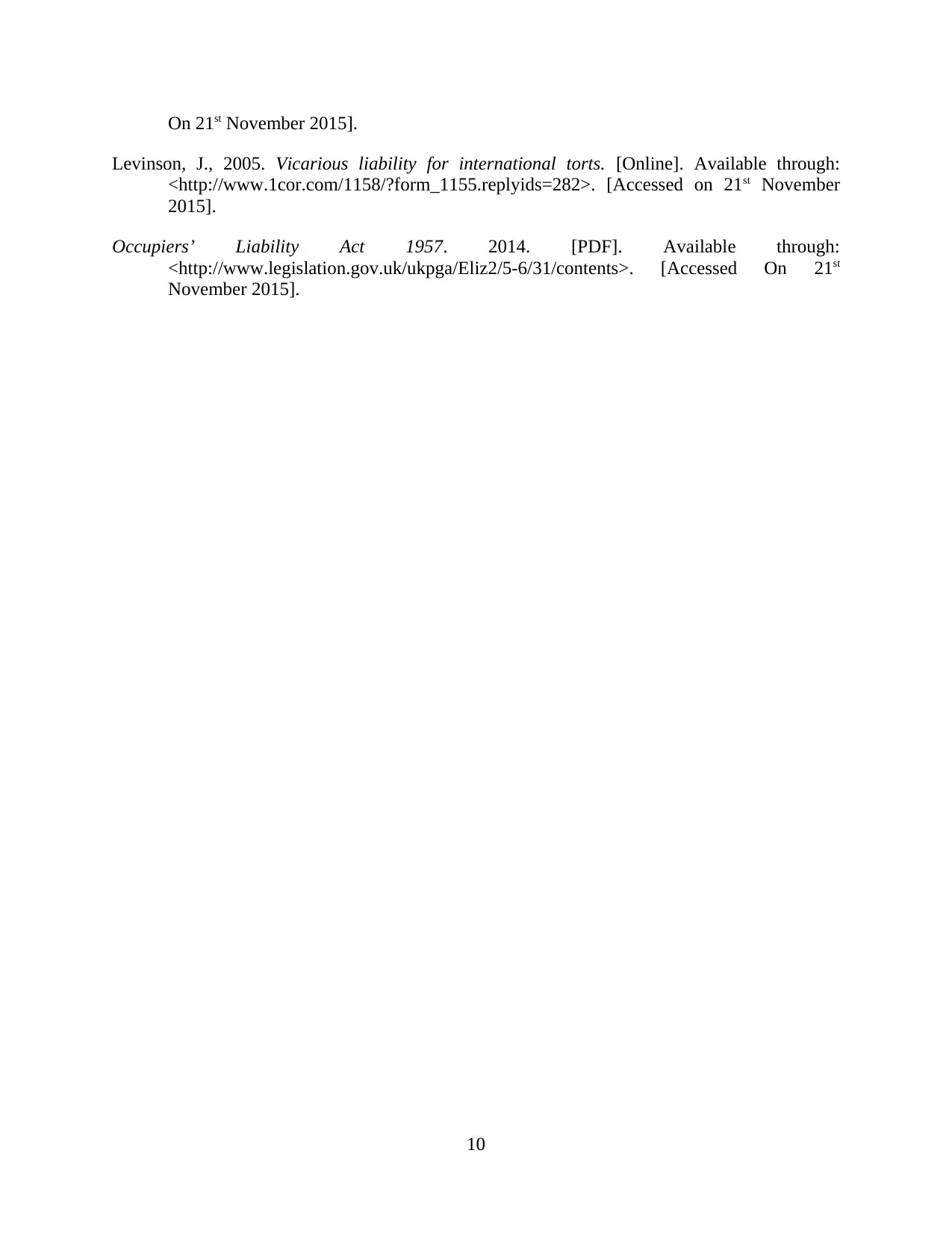
On 21st November 2015].
Levinson, J., 2005. Vicarious liability for international torts. [Online]. Available through:
<http://www.1cor.com/1158/?form_1155.replyids=282>. [Accessed on 21st November
2015].
Occupiers’ Liability Act 1957. 2014. [PDF]. Available through:
<http://www.legislation.gov.uk/ukpga/Eliz2/5-6/31/contents>. [Accessed On 21st
November 2015].
10
Levinson, J., 2005. Vicarious liability for international torts. [Online]. Available through:
<http://www.1cor.com/1158/?form_1155.replyids=282>. [Accessed on 21st November
2015].
Occupiers’ Liability Act 1957. 2014. [PDF]. Available through:
<http://www.legislation.gov.uk/ukpga/Eliz2/5-6/31/contents>. [Accessed On 21st
November 2015].
10
⊘ This is a preview!⊘
Do you want full access?
Subscribe today to unlock all pages.

Trusted by 1+ million students worldwide
1 out of 12
Related Documents
Your All-in-One AI-Powered Toolkit for Academic Success.
+13062052269
info@desklib.com
Available 24*7 on WhatsApp / Email
![[object Object]](/_next/static/media/star-bottom.7253800d.svg)
Unlock your academic potential
Copyright © 2020–2025 A2Z Services. All Rights Reserved. Developed and managed by ZUCOL.





